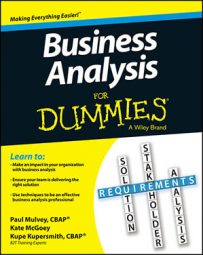Business analysis solutions deliver or help stakeholders achieve outcomes. People don’t create or use solutions just for fun; they do so because the solutions bring notable value. Commercial solutions find success when they provide so much value that people see it, appreciate it, and are willing to pay something for it.
How to validate the value of the solution for a business analysis
One way you, as a business analyst, can help the business hedge its bet that people will see and appreciate the value in the solution you’re working on (prerequisites to the decision of whether they’d pay for it) is to validate the value of that solution. A solution option value validation model is a graphical way to do just that.
![[Credit: Illustration by Wiley, Composition Services Graphics]](https://www.dummies.com/wp-content/uploads/390463.image0.jpg)
As you can see, a solution option must do all of the following to be successful:
Support and address the business need, whether that’s a user goal or an activity.
Avoid, reduce, or eliminate the business problem and its impacts.
Operate effectively and include expected or necessary capabilities.
Deliver results during use that enable achievement of the business outcome.
Provide additional value beyond the business outcome so that the audience appreciates that the option is a successful solution that fills the need.
All five requirements must be met for solution success. As long as the option you decide to put in place as the solution does those things, it will be a successful business solution.
How to take your audience into consideration in business analysis
If you have more than one potential option for solving the problem, selecting one requires evaluating and comparing one’s potential against the others’. Just how successful one solution is depends on how satisfied the business and other audiences are with the value they decide that option has. Your audience probably wants to understand that value before they want your solution.
The evaluation of a solution’s value can be subjective. Some people may find value in cutting-edge innovations and novelty items because they get pleasure from having something new and cool or in doing things they haven’t thought of before. But overall, value is realized when your solution provides your audience with outcomes or benefits that are better, faster, and cheaper than what they have now.
Thus, the audience for your solution — whether buying, adopting, or sponsoring and funding — wants to know, “Why should I consider this solution? What’s the value to me?” (This solution requirement is otherwise known as WIIFM: “What’s in it for me?”) Before selecting one particular approach to solve the problem, be sure you know what your audience members value:
Does the solution option need to just solve their problem or to go above and beyond? What’s their vision for the solution in terms of form, function, and permanence?
For instance, if they need a boat to cross a lake, which are they thinking of: raft, kayak, canoe, rowboat, motorboat, speedboat, yacht, or cruise ship? A raft can do the bare-bones job of getting them from A to B, but the other options do so with more bells and whistles. Identify, create, and innovate key functions and features for a useful, desirable solution.
What do they really need (versus want)? Maybe they want a speedboat, but a rowboat would still meet the need to get across the water. What are the critical outcomes that the solution must deliver, according to your audience?
Identify what the users would do with the solution that would make it helpful and valuable toward solving their problems or meeting their goals. Then, how perfect does it need to be right now for the audience? If more than one group benefits, who has the most influence over use or revenue? What does that group need most?
Which option is the best solution option for multiple audiences? This answer depends on what’s best for the business, for the users, and for any other beneficiaries, given all the issues and tradeoffs.
For example, given all the options and constraints at the lake, maybe the motorboat is best because it’s least expensive of the faster options, bringing value to the boater because she doesn’t have to row and value to the buyer with its lower cost profile.

